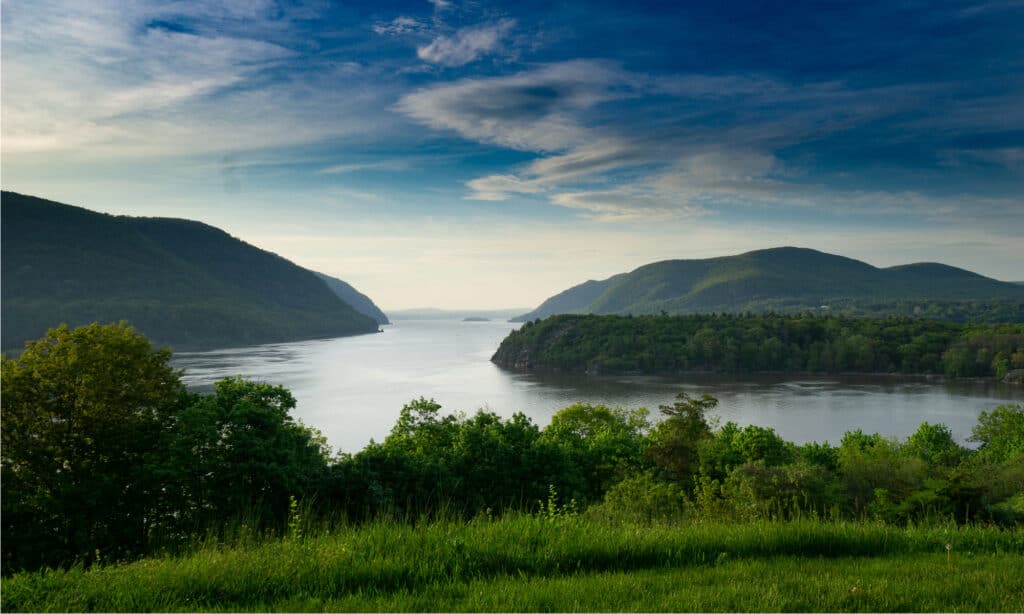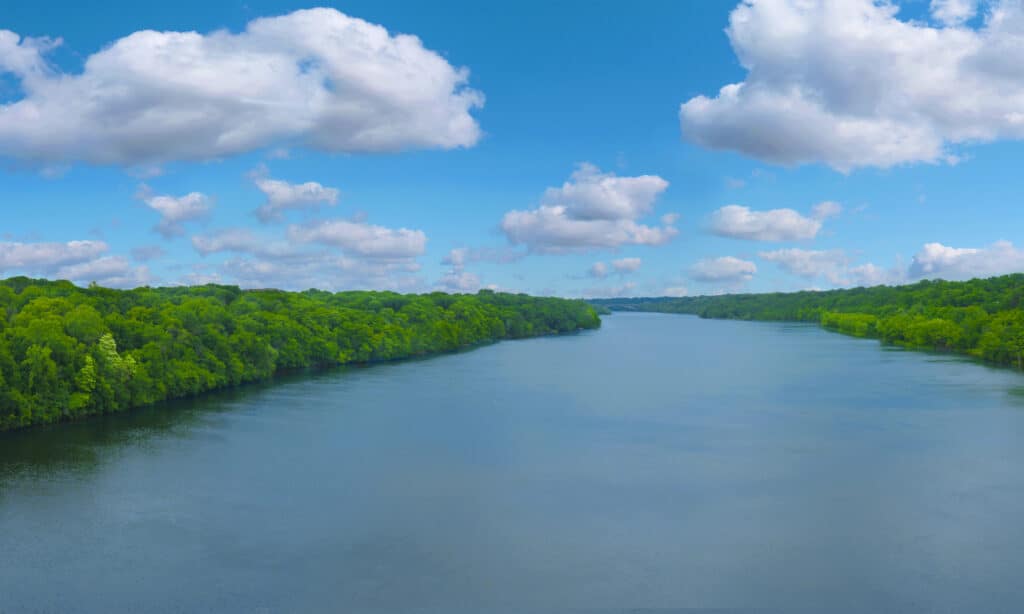The United States is home to some incredibly long, complicated, and beautiful rivers that provide drinking water and trade channels for its many citizens. Although the United States is renowned for some of its very large and deep lakes, its rivers don’t run quite as deep. Today, we are going to look at the deepest river in the United States, and show you how its depth compares to others in the country and around the world.
What Determines the Depth of a River?

A high river discharge can cause more erosion and increase river depths.
©RPBaiao/Shutterstock.com
Several factors can affect how deep a river flows. For example, a river flow could exert more erosive power powers vertically than horizontally, keeping its channel narrow but increasing the depth.
Following that line of thinking, rivers with a high discharge rate, like the Amazon River, could keep pushing out water too fast for sediment to resettle, increasing the depth over time. Of course, geological activity can also alter a river’s depth at the beginning of its formation or over long periods of time.
One or more of these factors can determine a river’s depth.
What Is the Deepest River in the U.S.?

In spite of conflicting figures, the Hudson remains the deepest river in the United States
©Songquan Deng/Shutterstock.com
The deepest river in the U.S. is the Hudson River which reaches a maximum depth of 216 ft. Some sources also list this depth at 202 ft. Either way, this river is the deepest, though. However, if the river was that depth, it would be even more interesting and controversial because that would make it just two feet deeper than the second-deepest river.
Although many people guess that the Mississippi River is the deepest, the river only reaches 200 ft deep as it winds its way through New Orleans. The combined Missouri-Mississippi River system is famous for being the longest in the U.S. and one of the largest in the world.
Depending on whether the measurement is 202 ft or 216 ft, there may be a controversy brewing over which of these rivers can claim to be the deepest of the bunch.
Still, there is more to the Hudson River than its depth. Let’s take a closer look at the Hudson River to get a more complete view of this body of water.
Where Is the Deepest River in the U.S.?

The Hudson River flows between New York and New Jersey.
©Akitzhaber/Shutterstock.com
Arguably one of the most significant rivers in the United States, the Hudson River flows for only 315 miles, so it’s not one of the longest rivers in the United States.
Although some rivers have their deepest portion close to the end of their flow, that is not the case with the Hudson River. Instead, this river’s deepest portion is actually located upstream at the river’s widest section. This area can be found between Constitution Island and the United States Military Academy.
As the river flows toward Manhattan, it becomes much more shallow. In fact, the average depth of the river is only 32 ft at its lower portion. This depth allows commercial ships to traverse the waters in the area. Since this river flows near one of the most highly populated and busiest cities in the world, it must be primed for ships to pass.
Where Is the Hudson River Located on a Map?
The Hudson River’s headwaters are located in the Lake Tear of the Clouds in New York’s Adirondack Park. The Hudson River flows between New York and New Jersey and has its mouth in the Upper New York Bay, in an area between Jersey City and Manhattan.
Interesting Facts About the Hudson River
The Hudson River is atypical in a few ways. For example, the lower portion of the river doesn’t run neatly into its mouth at New York Bay. The lowest portion of the Hudson River is a tidal estuary that has a reputation for being difficult to navigate as a result of the changing tides.
The deep incursion of saltwater into the body of water makes the Hudson River a “drowned river,” also known as a ria. In fact, the river has both seawater and freshwater up to the area around the George Washington Bridge. The water continues to be brackish until a few miles upriver of its deepest point.
Also, the river is tidal nearly half of its length, up to the Federal Dam that is located 150 miles upriver in Troy.
So, not only is the Hudson River very deep and significant to the economy in this part of the world, but the composition of the water is simply unique.
Animals That Live in and Around the Hudson River

Gray, harp, harbor, and hooded seals may occasionally be spotted in the Hudson.
©Dolores M. Harvey/Shutterstock.com
The Hudson River is home to more than 220 species of fish including the glass eel, Atlantic tomcod, Atlantic sturgeon, hogchoker flatfish, and the lined seahorse. Oysters used to be abundant in the mouth of the river, but they nearly died out during the 20th century. Current conservation measures, however, are bringing them back to New York Harbor.
Crustaceans such as the green crab and the Japanese shore crab live on its shores as does the Diamondback Terrapin. A humpback whale trailing its lunch (predominantly the Atlantic menhaden) may occasionally be found in the river as well. Gray, harbor, harp, and hooded seals might make an appearance, too.
The Hudson River Valley also boasts 19 species of rare birds. Among these birds are the bald eagle and the Peregrine falcon. Added to that prize are 140 rare plants, including the Hudson River Water Nymph, an aquatic, string-like plant. It has the Hudson River as part of its name because it grows no other place in the world!
Other Deep Rivers in the United States

The Mississippi River is the second-deepest river in the U.S.
©Milen Mkv/Shutterstock.com
The Hudson River is the deepest in the U.S., and the Mississippi River is not far behind. A major tributary of the Mississippi River is the Ohio River, one of the longest in the country. The Ohio River reaches a maximum depth of about 130-167 ft deep depending on the source of the measurement.
The Yukon River that flows from Canada and through most of Alaska only measures about 60 ft deep despite flowing almost 2,000 miles.
No other rivers in the United States come close to these measurements, meaning the U.S. is only home to a few rivers that are deeper than 100 ft.
Historical Importance of the Hudson River
While no other river in the US can compete with the Hudson River in depth, it also carries historical significance for our nation. Referred to as Muhheakunnuk or “great waters constantly in motion” by the Mohican Indians, the Hudson River was important for providing trade routes up to Canada, the Great Lakes region, and eventually the Mississippi River. It was also a place where many historical conflicts played out, such as the Revolutionary War. It’s the river that George Washington and his armies famously crossed in 1779.
What Is the Deepest River in the World?

The Congo River is not only the deepest river in the world but is also one of the longest on the continent of
Africa
©iStock.com/Fanny Salmon
Now that we know that the Hudson River is the deepest river in the United States, it’s only fair to wonder how this would measure up against the deepest one in the world.
The Congo River is the deepest in the world at a depth of 720 ft. Not only is this river incredibly deep, but it’s also one of the longest rivers in Africa. This river measures 2,920 miles from its start until it reaches its mouth in the Atlantic Ocean, producing a massive discharge.
The Hudson River is an interesting body of water, and it’s essential for many reasons including trade, water supplies, and travel. Although it only runs a little over 300 miles in length, the Hudson River is the deepest one in the entire United States.
The country is not home to many exceptionally deep rivers, but the Hudson River is an especially famous and storied body of water.
The photo featured at the top of this post is © Songquan Deng/Shutterstock.com
Thank you for reading! Have some feedback for us? Contact the AZ Animals editorial team.







